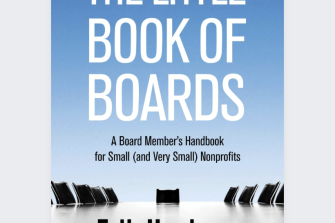Surprisingly, many boards have no agreed process for decision making. Purdy and Estall’s excellent book can help.
One reason we really like this work is the extraordinary alignment with other areas of good practice we believe in. First, it states that all decisions begin with purpose:“the most successful conversations around decision making are those where the Decider ensures they are explicitly framed by the organisation’s ultimate Purpose.”
You can view this as outcome-based thinking or align it to Simon Sinek’s focus on ‘why’ or Jim Collin’s hedgehog concept. The question is always: what is the nature of the change we are trying to make in the world; or the customer need to be met? Then, how does this decision make the boat go faster?
The thinking in the book also aligns to Roger Martin’s idea of cascading strategy. Every decision or set of decisions provides the framework for decision making the next level down and so on. Again, very aligned to the board’s role in setting limitations or policy frameworks that guide all decision making. Estall and Purdy point out that organisational success depends on the cumulative effect of many small decisions as well as the big decisions on which they are based.
Early in the book they propose a universal methodology for decision making, then go on to analyse the elements. The model is quite simple; it links purpose, opportunity, decisions and outcomes. It reminds us that opportunities sit within and are a product of context. Context is, of course, highly mutable. Making a decision is an iterative process that generates options or ‘tentative decisions’. Post-decision monitoring will detect any change in the context or variation in implementation. Adjustment may be required.
Most decisions do not have perfect certainty associated with them—trying to achieve absolute certainty can be both time- and cost-prohibitive. The authors offer a good checklist to frame decision thinking: What don’t I know? What am I unsure of? Are there other options? What am I assuming? What are my biases? What could change?
The authors note that assumptions during the process are seldom avoidable, and underpin most decisions. Assumptions must be recorded and made clear if each is believed to be a fact or some degree of supposition. They also suggest plotting assumptions on a grid, mapping confidence and criticality. How confident are we in each assumption and what is its influence in achieving the desired outcome? It is also important that we consider any actual or potential interdependencies between assumptions. Obviously in the decision-monitoring phase, a review of assumptions is essential.
The context is important. The future is not set, and decision makers should not hold one static view of it. The authors note that the context for any decision has three bands that can affect implementation: internal to the organisation, immediate stakeholders and wider influences. The latter can include technology, events, regulatory change, social norms etc. Any change within these bands can make the decision flawed. They also stress the need to connect seemingly unrelated changes. Cited are the various technology advances that—when aggregated and added to customer dissatisfaction with the status quo—produced Uber.
A good question to consider is how vulnerable to unexpected change is our decision.
High-importance decisions need to be recorded in detail, including: the process followed; who was involved; analysis of the prevailing context; main assumptions used; and whether the decision had multiple elements to it. The detail is important in the boardroom. Often, we see boards making a decision and management being less than clear about what is asked of them. If the decision can be legally challenged, detailed recording is vital.
An excellent and scathing section on risk management and how the practice evolved makes the book worth a read—even just for this section which we have reviewed in greater detail elsewhere [1]. The authors’ view is that risk management was something dreamed up by the insurance industry and foisted on their clients. Then a whole industry evolved. They state that, “much of what comes with risk management is illogical and defies common sense”. The idea of pairing risk and opportunity they suggest is “about as logical as pairing bulldozers with cauliflowers”.
The book concludes with a useful set of templates and prompt cards.
We know that if a poor or absent decision process results in a great outcome, it is likely dumb luck and may not be able to be repeated. If a good process is followed but a poor outcome results, the process will allow learning, adjustment and will help prevent a repeat. Research [1] backs this up, noting that the process used matters more than analysis by a factor of six.
This is a great read. Anyone making decisions should add this to the bookshelf.
Notes
[1] ‘Is your board feeling the weight of the risk management millstone?’ Good Governance #89
[2] Dan Lovallo and Olivier Sibony in McKinsey March 2010








